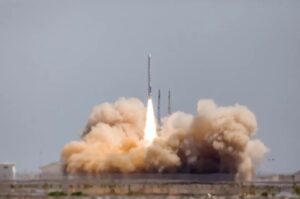Hyperbola-1 four-stage rocket lifted off from Jiuquan Satellite Launch Center in the Gobi Desert on Feb.1, marking the second launch of a Hyperbola-1.
Bystander footage (since deleted) appeared on Chinese social media shortly after liftoff, suggesting the launcher had dramatically veered off course. Official confirmation of launch failure followed hours later.
An iSpace press release March 1 (Chinese) stated that it had completed fault location diagnosis, fault simulation and prediction, test verification and assessment and improvement measures following 28 days of investigation and analysis.
According to iSpace a piece of foam insulation, intended to fall off, struck and impeded one of four grid fins at the base of the first stage. The insulation foam later fell free, resulting an a change of angle of the grid fin and then subsequent rapid change of attitude and breakup of the launch vehicle.
The loss of the mission coincidentally followed 18 years to the day of the Columbia disaster. A piece of foam insulation broke off from the Space Shuttle’s external tank during launch and damaged a wing of the Orbiter, later leading to catastrophe on reentry.
The iSpace press release did not reveal the payloads lost on the mission, though a number of small satellites were understood to be onboard. Beijing Ark Space Technology Co. Ltd., a private space firm, issued a press release (Chinese) shortly after launch to refute reports that its Ark-2 satellite was aboard the flight. It stated that the previously existing launch service relationship with iSpace had been amicably terminated in December.
Beijing-based iSpace said it will strengthen management and technical capabilities, enhance quality awareness, improve risk identification and take other measures. The company is now understood to be planning a next Hyperbola-1 launch in the next few months.
Hyperbola-1 consists of three solid stages with a liquid-propellant fourth stage. It has a length of 20.8 meters and mass at takeoff of around 31 metric tons. The launcher has three solid stages with a liquid-propellant fourth stage.
However images of the first and second Hyperbola-1 rockets suggest significant changes in design between the two launches.
Hyperbola-1 has gone through some significant changes between Y1 & Y2
1:@goneless
2:https://t.co/TC6pTKMEiO pic.twitter.com/vzHNDw9RHq
— LaunchStuff (@LaunchStuff) February 1, 2021
The first Hyperbola-1 successfully placed a satellite in orbit in July 2019, making iSpace the first nominally private firm to achieve the feat, following failed attempts from fellow Chinese firms Landspace and Onespace in October 2018 and March 2019 respectively.
Also known as Interstellar Glory, the firm is one of more than 20 launch vehicle-related firms established in China following a 2014 central government policy shift which opened the launch and small satellite sectors to private capital.
These companies are competing for commercial launch contracts, outside of the activities of China’s main state-owned space contractor, CASC.
iSpace faces competition in solid light-lift launch services from nominally private Chinese counterparts Galactic Energy and OneSpace, as well as well-funded state-owned enterprise spinoffs Expace, China Rocket and CAS Space.
Last year iSpace raised $173 million in series B funding. This was stated to be used for development of the 28-meter-tall, 3.35-meter-diameter Hyperbola-2 liquid oxygen-methane launcher with a vertically-recovered and reusable first stage.
Hyperbola-2 is to be capable of lifting over 1,100 kilograms of payload into a 500-kilometer Sun-synchronous orbit, or 800 kilograms when the first stage is to be recovered and reused.
iSpace is planning to conduct 100-kilometer vertical take-off and landing tests with the Hyperbola-2 first stage next year. A full orbital flight was planned for the end of 2021 or 2022.
Again iSpace faces a number of competitors in medium-lift liquid launchers, most immediately and notably from Landspace, Galactic Energy and Deep Blue Aerospace, though a diverse range of launch vehicles are being planned and developed by other actors.
Companies manufacturing satellites or planning their own constellations have also emerged since 2014, including optical and synthetic aperture radar remote sensing, communications and navigation applications.
This apparent rapid development of China’s commercial space sector and ecosystem in recent years could therefore offer opportunities for new launch providers capable of reliably achieving orbit.
China’s National Development and Reform Commission (NDRC) added ‘satellite internet’ to a list of “new infrastructures” in April 2020, leading to increased investment in satellite-related companies.
Automaker Geely has also entered the space sector, recently gaining approval for manufacturing satellites for navigation enhancement and vehicle connectivity to support automated self-driving cars.



